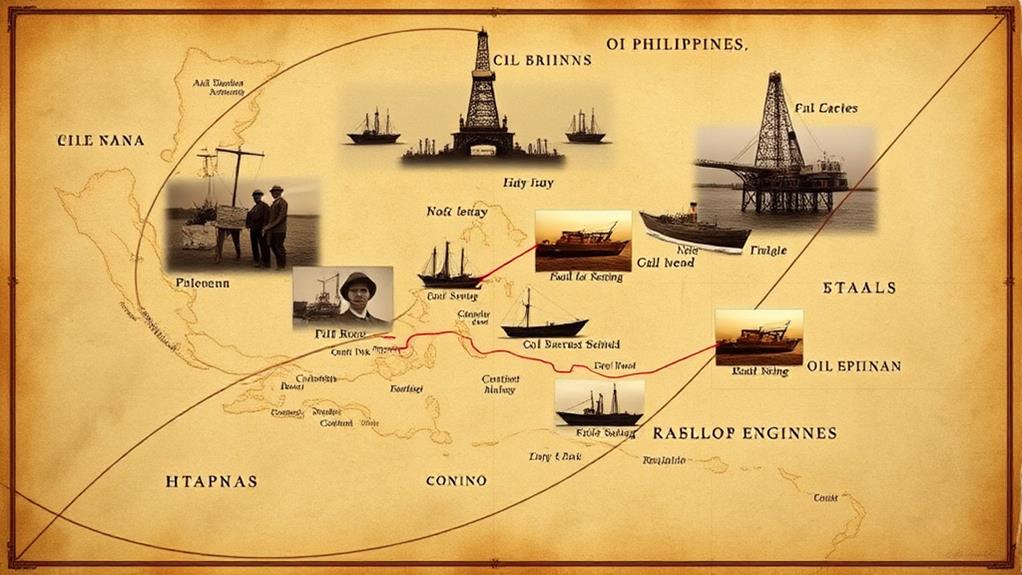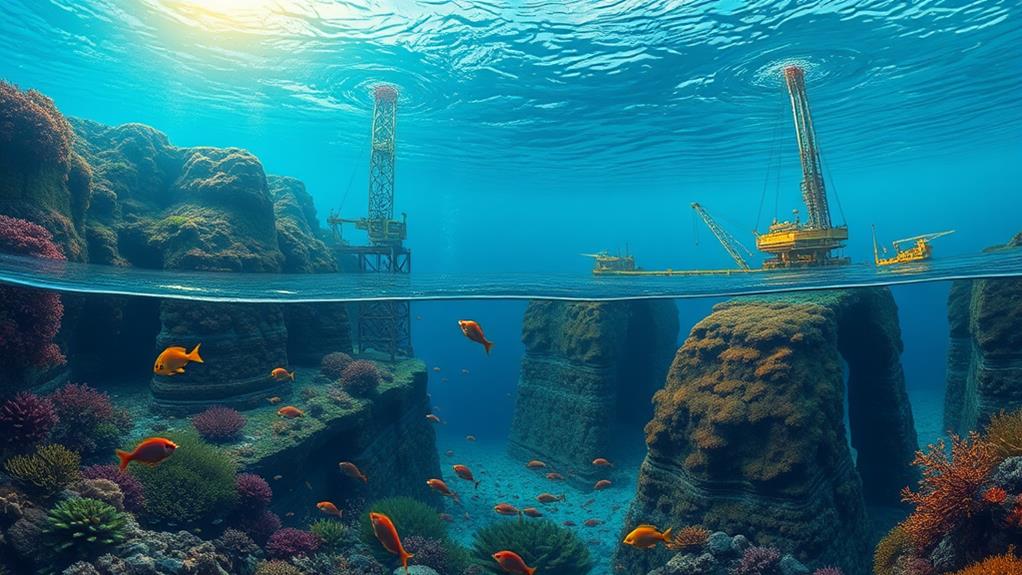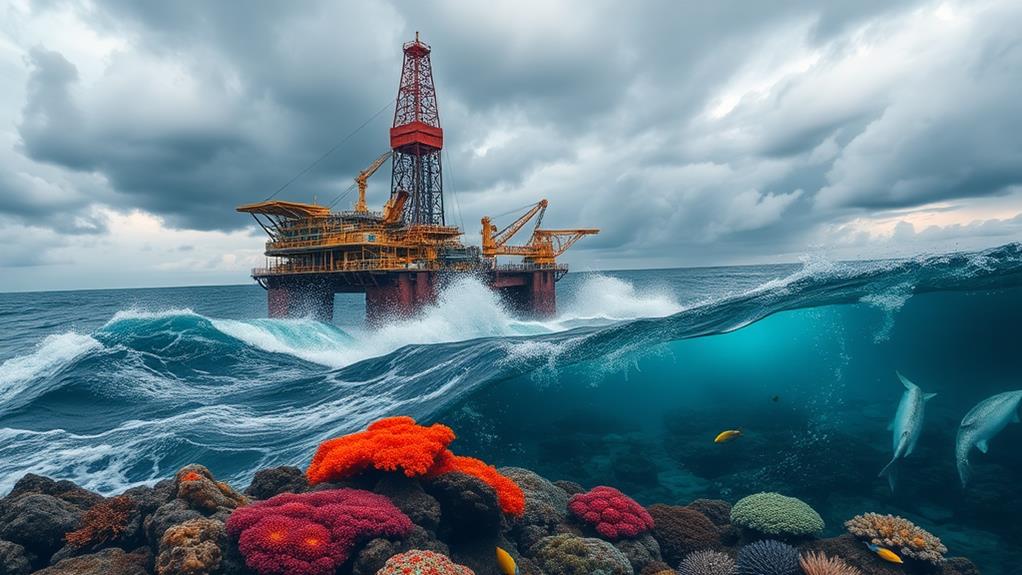The oil and gas industry in Philippine waters has great opportunities for exploration and production. The Malampaya gas field is a key source of energy but is expected to run out by 2027.
There are untapped resources worth about $26.3 trillion, but geopolitical tensions and regulatory hurdles make progress difficult. Areas like the Sulu Sea and East Palawan show promise for new discoveries, but they need aggressive exploration strategies.
Using advanced technologies can help make the exploration more efficient. However, there are community concerns and environmental issues that can complicate these efforts.
Understanding these factors is important to see the industry's potential and future plans.
Oil Exploration History

The oil exploration history in the Philippines began in 1896 with the drilling of the Toledo-1 well in Cebu. This event marked the country's entry into the petroleum industry.
In 1949, the Petroleum Act was enacted, creating a concession system that led to increased exploration activities from the 1950s to the 1970s.
A key discovery occurred in 1977 with the Nido offshore oil field, which encouraged more offshore drilling. The most significant find happened in 1990 with the Malampaya gas field, which is essential for generating electricity and providing revenue for the government.
Despite these advancements, only about 10% of the Philippines' land has sufficient information for oil exploration. This indicates a large amount of untapped potential in the country's hydrocarbon resources.
Further exploration could lead to significant economic benefits and improved energy security in the future.
Malampaya Gas Field Overview
The Malampaya Gas Field is the largest commercial deepwater gas field in the Philippines. Discovered in 1990, it has estimated reserves of 2.7 to 3.2 trillion cubic feet (Tcf) of natural gas. Since starting operations in January 2002, it has generated over USD $12 billion in revenue for the Philippine government and supplies up to 20% of Luzon's electricity needs.
By the end of December 2017, it produced 1.94 Tcf of gas and 75 million barrels of associated condensate, making it a key energy source.
The field's reserves are expected to be depleted by 2027, which raises concerns about future energy security. This situation highlights the need for new exploration activities and alternative energy sources to prevent shortages.
Udenna Corporation is working on plans to extend the field's lifespan and use its remaining resources effectively. The Malampaya Gas Field is crucial for the Philippines' energy needs and encourages future exploration in the country's natural gas sector.
Untapped Hydrocarbon Resources

The Philippines has about $26.3 trillion in untapped hydrocarbon resources. Most of these resources are in areas with territorial disputes, like the Spratly Islands, which makes exploration difficult.
The Liguasan Marsh is thought to contain 4.8 billion barrels of crude oil and 9.3 trillion cubic meters of natural gas, but community resistance is stopping development there.
The East Palawan Basin has around 166 million barrels of oil equivalent, yet only five exploratory wells have been drilled. This shows that the area isn't well explored.
The Recto Bank is estimated to have at least 600 billion cubic feet of gas, but geopolitical tensions and regulatory issues are slowing down progress.
Although there are contracts for exploration in different areas, the Philippine government is having trouble moving forward. They need to improve regulatory frameworks and work together with other parties.
Key Exploration Areas
Exploration in the Philippines is concentrating on areas with high potential for oil and gas production.
The Alegria site in Cebu has discovered 27.93 million barrels of oil and 9.42 billion cubic feet of natural gas.
Another significant area is Liguasan Marsh, which is estimated to hold 4.8 billion barrels of crude oil and 9.3 trillion cubic meters of natural gas, although there's community opposition to exploration there.
The Spratly Islands are also promising, with an estimated 28 billion barrels of oil according to the USGS.
However, geopolitical tensions make exploration difficult.
Other regions like the Sulu Sea, Celebes Sea, and Philippine Sea show potential, but their reserves haven't yet been estimated.
Challenges in Development

The oil and gas sector in the Philippines faces major challenges that slow down its growth. Geopolitical disputes in the South China Sea make it hard to explore new areas, limiting access to valuable resources.
Although the country has a long history of oil extraction, there is a lack of experience in exploration and management, which leads to slow progress on contracts already awarded.
Regulatory challenges worsen the situation, as slow bureaucratic processes hinder development. The Philippine government needs urgent reforms, especially because production rates are declining.
Additionally, community opposition and environmental concerns make exploration difficult, particularly in high-potential areas like the Liguasan Marsh, which is believed to hold about 4.8 billion barrels of crude oil.
The sector has an estimated hydrocarbon potential worth around $26.3 trillion, but much of it remains untapped.
If these issues aren't resolved, the potential of the oil and gas industry in the Philippines will continue to decrease, limiting investment opportunities and jeopardizing national energy security.
Technological Advances in Exploration
Recent advancements in technology have greatly improved oil and gas exploration in the Philippines. These improvements have made exploration more efficient and accurate. For example, artificial intelligence and digital tools are now essential for exploration tasks. They help enhance the quality and amount of production.
One significant technology is advanced seismic imaging. This technique helps identify potential hydrocarbon deposits in less-explored areas like the East Palawan and Sulu Sea basins.
Another important tool is 3D geological modeling, which changes how resource estimates are made. This method improves planning in areas such as Recto Bank, allowing for better resource allocation and risk management.
Remote sensing technology is also vital. It enables real-time monitoring of environmental conditions, which is crucial for assessing if offshore drilling is feasible, especially in disputed waters.
Additionally, new drilling techniques, like horizontal drilling and hydraulic fracturing, are being explored to increase recovery rates from known reserves, particularly in the Malampaya gas field.
How Does the Oil and Gas Industry Impact Marine Resources in Philippine Waters?
The oil and gas industry’s activities can affect marine resources in Philippine waters. Implementing sustainable fishing practices is crucial to minimize the impact of offshore drilling and ensure the protection of marine life and ecosystems. It is essential for the industry to consider these practices and work towards environmental conservation.
Geopolitical Factors Impacting Exploration

Geopolitical tensions make oil and gas exploration difficult in Philippine waters, especially in the South China Sea. China's claims over this area limit access to potential oil and gas reserves. The U.S. Geological Survey believes that the Spratly Islands could have up to 28 billion barrels of oil, but these resources remain mostly untapped because of disputes with China and other ASEAN countries.
| Factor | Impact on Exploration Activities |
|---|---|
| China's Territorial Claims | Limits access to potential reserves |
| Maritime Clashes | Increases risks for exploration vessels |
| Stalled Partnerships | Delays resource development |
| Alternative Investments | Provides additional support for exploration |
| Energy Talks with China | Aims to balance resource control and territorial rights |
Clashes between Philippine and Chinese coast guard vessels highlight the difficulties in this region. Past attempts to form joint exploration partnerships with China have failed due to rising tensions. As a result, the Philippines is seeking investments from allies like the U.S., Japan, and Australia. Additionally, by engaging in energy talks with China, the Philippines hopes to manage these complex issues while maintaining control over its resources.
Future Prospects and Strategies
Navigating oil and gas exploration in the Philippines requires a clear plan for the future. The government needs to focus on becoming energy self-sufficient because the Malampaya gas field may run out by 2027. This depletion could impact 20% of Luzon's electricity supply.
To tackle this issue, increasing exploration activities in the East Palawan and Sulu Sea basins is essential since these areas have good potential for oil and gas.
The Department of Energy's campaign, called "Explore, Explore, Explore," stresses the importance of drilling more wells. From 2013 to 2018, only three wells were drilled each year, which isn't enough.
To improve this, there should be changes to make operational processes easier and faster. Forming partnerships with foreign investors from the U.S. and other allied countries is also crucial. This is especially important in areas like the South China Sea, where there are geopolitical issues.
Questions and Answers
What Is the Oil Exploration Law in the Philippines?
In the Philippines, oil exploration laws require companies to obtain exploration permits. These permits are necessary legal documents that allow companies to search for oil and gas in specific areas.
Companies must also follow environmental regulations. This means they need to protect the environment and avoid harming natural resources during their exploration activities. For example, they must conduct environmental impact assessments to identify potential harm to local ecosystems.
Additionally, there are investment incentives available for companies that explore for oil. These incentives can include tax breaks or financial support from the government. They encourage companies to invest in oil exploration, making it more appealing for businesses.
Why Is the Oil and Gas Industry Important in the Philippines?
The oil and gas industry is vital for the Philippines' economy. It helps the country become more energy independent. By using local oil and gas resources, the Philippines can reduce its reliance on imported energy. This not only boosts energy security but also supports sustainable development. For example, tapping into local resources can create jobs and lower energy costs for consumers. Overall, focusing on the oil and gas industry is crucial for the Philippines' growth and stability.
What Is Exploration and Production of Oil and Gas Industry?
Exploration and production in the oil and gas industry include offshore drilling, seismic surveys, and resource management.
Offshore drilling involves creating holes in the ocean floor to reach oil and gas reserves. For example, companies use large drilling rigs to extract resources from beneath the sea.
Seismic surveys help identify where oil and gas might be located underground. This process uses sound waves to create images of the Earth's layers, allowing companies to find potential reserves.
Resource management ensures that these resources are extracted responsibly. This includes assessing the size and quality of reserves to determine if they are worth extracting, ensuring that the energy demands are met while promoting sustainability.
Where Is the Philippines Largest Untapped Oil Reserves Located?
The largest untapped oil reserves in the Philippines are found in the Spratly Islands. Geological surveys indicate that there is a potential for 28 billion barrels of oil in this area. This makes the Spratly Islands a significant site for future oil exploration.